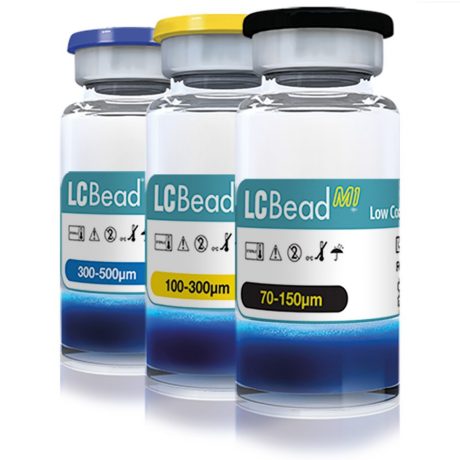LC BeadTM Safety warning
INDICATIONS
LC Bead microspheres are intended to be used for the embolisation of hypervascular tumors and arteriovenous malformations (AVMs).
CONTRAINDICATIONS
- Patients intolerant to occlusion procedures
- Vascular anatomy or blood flow that precludes catheterplacement or emboli injection
- Presence or likely onset of vasospasm
- Presence or likely on set of hemorrhage
- Presence of severe atheromatous disease
- Presence of feeding arteries smaller than distal branches fromwhich they emerge
- Presence of patent extra-to-intracranial anastomoses or shunts
- Presence of collateral vessel pathways potentially endangeringnormal territories during embolisation
- Presence of end arteries leading directly to cranial nerves
- Presence of arteries supplying the lesion not large enough toaccept LC Bead microspheres
- Vascular resistance peripheral to the feeding arteries precludingpassage of LC Bead microspheres into the lesion
- Do not use LC Bead microspheres in the following applications:
- Embolisation of large diameter arteriovenous shunts (ie. where theblood does not pass through the arterial/capillary/venous transitionbut directly from artery to vein
- The pulmonary arterial vasculature
- Any vasculature where the use of LC Bead Embolic Agent could pass directly into the internal
Embolisation with LC Bead microspheres should only be performed by physicians who have received appropriate interventional occlusion training in the region intended to be embolised.
POTENTIAL COMPLICATIONS
- Undesirable reflux or passage of LC Bead microspheres into normal arteries adjacent to the targeted lesion or through the lesion into other arteries or arterial beds, such as the internal carotid artery, pulmonary, or coronary circulations.
- Pulmonary embolisation
- Ischemia at an undesirable location
- Capillary bed saturation and tissue damage
- Ischaemic stroke or Ischaemic infarction
- Vessel or lesion rupture and hemorrhage
- Neurological deficits including cranial nerve palsies
- Vasospasm
- Death
- Recanalisation
- Foreign body reactions necessitating medical intervention
- Infection necessitating medical intervention
- Clot formation at the tip of the catheter and subsequent dislodgement
LC BeadTM M1 Safety warning
INDICATIONS
LC Bead M1 are intended to be used for the embolization of hypervascular tumors and arteriovenous malformations (AVMs).
CONTRAINDICATIONS
- Patients intolerant to occlusion procedures
- Vascular anatomy or blood flow that precludes catheter placement or emboli injection
- Presence or likely onset of vasospasm
- Presence or likely on set of hemorrhage
- Presence of severe atheromatous disease
- Presence of feeding arteries smaller than distal branches from which they emerge
- Presence of patent extra-to-intracranial anastomoses or shunts
- Presence of collateral vessel pathways potentially endangering normal territories during embolization
- Presence of end arteries leading directly to cranial nerves
- Presence of arteries supplying the lesion not large enough to accept LC Bead M1
- Vascular resistance peripheral to the feeding arteries precluding passage of LC Bead M1 into the lesion.
- Do not use LC Bead M1 in the following applications:
- Embolization of large diameter arteriovenous shunts (ie. where the blood does not pass through the arterial/capillary/venous transition but directly from artery to vein
- The pulmonary arterial vasculature
- Any vasculature where LC Bead M1 Embolic Agent could pass directly into the internal carotid artery or other nontarget territories
WARNING
Studies have shown that LC Bead M1 do not form aggregates and, as a result, penetrate deeper into the vasculature as compared to similarly sized PVA particles. Care must be taken to choose a larger sized LC Bead M1 Embolic Agent when embolizing arteriovenous malformations with large shunts to avoid passage of the microspheres into the pulmonary or coronary circulation.
The color of the LC Bead M1 could be visible through the skin if injected into arteries feeding superficial tissues.
POTENTIAL COMPLICATIONS
- Undesirable reflux or passage of LC Bead M1 into normal arteries adjacent to the targeted lesion or through the lesion into other arteries or arterial beds, such as the internal carotid artery, pulmonary, or coronary circulations
- Non-target embolization
- Pulmonary embolization
- Ischemia at an undesirable location
- Capillary bed saturation and tissue damage
- Ischemic stroke or Ischemic infarction
- Vessel or lesion rupture and hemorrhage
- Neurological deficits including cranial nerve palsies
- Vasospasm
- Death
- Recanalization
- Foreign body reactions necessitating medical intervention
- Infection necessitating medical intervention
- Clot formation at the tip of the catheter and subsequent dislodgement.

